
Tourism in Middle East and North Africa (Mena) – which together attracted nearly 40 million tourists in 2003 – is on the upswing in general and poised for further growth, latest statistics from research specialist Deloitte & Touche, aircraft manufacturing giant Airbus Industrie, and the World Tourism Organisation (WTO).
The Mena region comprises Algeria, Bahrain, Djibouti, Egypt, Iran, Iraq, Israel, Jordan, Kuwait, Lebanon, Morocco, Oman, Palestine, Qatar, Saudi Arabia, Syria, Tunisia and Yemen and the UAE.
Breaking the statistics into two sectors, the WTO says that the Middle East attracted 27.6 million tourists in 2003 and earned $13.7 billion in tourism receipts, while North Africa recorded 10.3 million arrivals and tourism receipts of $4 billion.
Also, the WTO says that Mena recorded the highest regional growth rate in the world of 17 per cent, compared to the world average of 3 per cent in the same year. This was in line with the Middle East’s average annual growth rate of 12 per cent between 1995 and 2000, barring a one per cent decline in 2001, it says.
However, growth in North Africa slumped by 2.4 per cent.
The reason for this contrast, according to the WTO, is the Middle East’s strong intra-regional market, further boosted by the fallout from 9/11, with more high-spending outbound tourists opting to holiday within the region itself.
Sharing the bullish sentiment about growth in the region is aircraft manufacturer Airbus, which predicts that Mena airlines will need 950 aircraft worth $94.5 billion by 2022 to ferry the millions of travellers to and from the region.
Airbus hopes to win at least half of the market with its family of aircraft, which range from 100 seats up to the 555-seat A380. Overall, carriers in the Middle East have placed cumulative orders for more than 300 Airbus aircraft, some 250 of which have been delivered.
MIDDLE EAST
Deloitte & Touche meanwhile reports that in the first 10 months of last year, hotels in the Middle East regained lost ground against 2003. All Deloitte’s 27 ‘markets’ recorded double-digit growth in revenue per available room (revPAR), except Kuwait City, Provincial Saudi Arabia and Riyadh, Deloitte & Touche said in its Hotel Benchmark Survey, released last December.
“The Middle East continues to be the centre of much attention. Aside from the ongoing media coverage of political events, the number of international and inter-regional visitors has grown, exceeding other global destinations,” the report stated.
“According to the International Air Transport Association the region has seen a 29 per cent rise in air passenger traffic in the past nine months. Statistics compiled by the World Tourism Organisation show Lebanon (30 per cent), Jordan (18 per cent), Bahrain (19 per cent) and Dubai (9 per cent) reporting the highest growth in visitor arrivals compared to the same period in 2003.
“These improvements in air passenger traffic and inter-regional travel activity have naturally had a positive impact on hotel performance. Year-to-October 2004 hotel occupancy levels in Lebanon’s largest city, Beirut, have increased by 19.6 per cent while average room rates climbed $12 to $151 compared to the same period in 2003.
“Jordan’s capital, Amman, has seen revPAR grow by 52.1 per cent following three years of poor occupancy performance. Average room rates in Manama have achieved steady year-on-year increases since 2000, peaking at $128 year-to-October 2004. Not surprisingly, hotels in Dubai’s Jumeirah Beach continue to be among the region’s top performers with revPAR climbing to $188.
Deloitte says that the strong improvement in 2004 hotel performance against last year masks the low base from which some of these markets have grown.
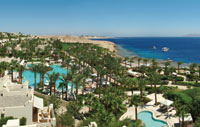 |
|
Upmarket destination ... the |
EGYPT
“All hotel markets in Egypt have witnessed double-digit revPAR growth year-to-October 2004 against the same period last year. Despite this many Egyptian markets have yet to recover the losses incurred during 2001 and 2002. During 2003, Cairo Pyramids, Hurghada, Red Sea Resorts and Sharm El Sheikh were amongst the first to see rate improvements although these were nominal. Year-to-October 2004 revPAR has remained below $50 in all markets, except Cairo City Centre ($60) however this was as low as $15 in Luxor. To date, the only Egyptian markets to surpass 2000 revPAR results are Hurghada, Red Sea Resorts and Sharm El Sheikh.”
Official statistics from Egypt are impressive: Egypt’s Prime Minister Ahmed Nazif recently reported that tourism revenues grew 43 per cent in 2004 to $6.6 billion, compared to $4.6 billion in 2003.
Nazif said tourists spent 88 million nights in Egypt in 2004 – a 65 per cent rise on 2003. Previously released figures show the number of visitors to Egypt in 2004 increased 34 per cent to 8.1 million.
For the hotel industry, which has been reeling under the impact of successive incidents starting with the second Gulf War, terrorist attacks, the Luxor incident, September 11, and the war on Iraq, this boom couldn’t have come at a better time. Even though new hotels are opening doors – Four Seasons at Nile Plaza and the InterContinental Heliopolis Cairo being the most recent to open – there are those who think that the sector’s expansion has been a little haphazard.
Before taking over office Al Maghraby, in his capacity of board chairman of Accor Hotels, too had remarked that there was a situation of over supply in terms of hotel capacity. He had argued that hotels should limit expansion until the rate per room reached a certain level. It’s true that the hotel industry, in general, had gone through bad times and the competition in a narrow market resulted in sharp reductions in room rates but now everybody in the business seems to be upbeat.
It helps matters that everything seems to have fallen into place – the hotels in Sharm El Sheikh and Hurghada are booked out, charter flights are streaming in from all over the world and all of Cairo seems to be spilling over with tourists.
And the good thing is that tourists have now started discovering an Egypt beyond the pyramids – they are heading for its fabled beaches, health spas and fantastic deserts. Lately, even golf has emerged as a major tourist attraction – even though deserts make up 95 per cent of Egypt’s land mass, the country boasts several deluxe golf courses, complete with accompanying world-class clubhouses and shopping malls have been developed in different tourist destinations such as the Red Sea, Sinai, Cairo and Luxor.
Given the fact that Sharm El Sheikh has been ranked fourth among the world’s most popular tourist destinations, the government is also pursuing further developments, particularly in south Sinai and by the Mediterranean Sea. If all goes according to plan, it will not come as a surprise if the government not only meets its target of attracting eight million tourists per annum by 2005 but ends up improving on that figure.
“Egypt, which received 8.103 million tourists last year is well on the world tourism map, and very prominently so. What I am aiming for is to advance Egypt’s position within the group of top world tourism destinations. This will be done by putting into operation a group of measures that would enable us to achieve an average growth rate of 10 per cent, whereby we will be able to double the number of tourist arrivals every seven years,” says Al Maghraby.
“One of my main concerns is the continuous improvement of our product. This means that every component should be constantly improved – whether that component is structural such as our airports, roads, hotels, tourist sites, or human such as our workforce in the tourism industry. This will be done by active and effective collaboration between the ministry of tourism and other ministries such as civil aviation, culture, transport, etc. Furthermore, great emphasis is now placed on human resources training both within the tourism sector and in other related sectors to raise our standards to international levels.
“Regarding Egypt’s image as a tourism destination, we closely work with the specialised media campaign management companies in charge of executing Egypt’s promotional campaigns all over the world.”
Saudi Arabia
Commenting on Saudi Arabian markets stepping up, Deloitte & Touche’s report states: “Saudi Arabia has been struggling to regain levels achieved in 2000. RevPAR fell to $25, a more significant decline than the loss incurred in 2003. This result was driven by a 13.8 per cent fall in average room rates, while its occupancy of just 27.5 per cent was the lowest recorded by any market in the Middle East.
“Encouragingly, other Saudi Arabian destinations such as Makkah and Jeddah have shown improvement and revPAR in each of these markets are above the levels achieved during the same period in 2000.
‘‘With occupancy levels struggling to reach 60 per cent in most markets in Saudi Arabia, the industry is currently unable to contend with such increases in supply. Despite this, evidence suggests steady growth in demand.
‘‘The country’s domestic market is an important segment for hoteliers as Saudis have shown a preference to holidaying at home. The population is expected to grow by 50 per cent to over 30 million within the next five years further underlining the importance of this segment.
“With 45.3 million tourists expected by 2020, foreign investment is needed to help increase accommodation supply by 50,000 hotel rooms and 74,000 housing units. A commitment to training over 2 million Saudi nationals to work in the sector has also been advanced.’’
Kuwait
In Kuwait, demand has turned away, according to the Deloitte report: “Kuwait’s hotels have benefited from war related demand which has helped push up average room rates. Over recent years occupancy has moved from 50 per cent in 2000 to reach a peak of 85 per cent last year. Unsurprisingly due to the displacement of demand, the results show occupancy levels falling 16.6 per cent compared to the same period in 2003. While the city was able to achieve a 4.6 per cent increase in average room rates, it has lost its position as the most expensive city tracked by the survey, a standing Kuwait held for four years.”
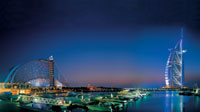 |
|
Major Jumeirah attractions ... |
DUBAI, UAE
Dubai’s Jumeirah Beach achieved a revPAR of $188 as both occupancy and average room rates continue to grow, Deloitte’s report said. “Year-to-October 2004, occupancy has peaked at 86.6 per cent while average room rates reached $218, positioning Jumeirah Beach with the highest occupancy, average rate and consequently revPAR of any of the 27 markets tracked across the Middle East.
“While Dubai City Centre lags behind the revPAR performance of Jumeirah Beach, hotels within this district recorded a second year of impressive rate growth. Moreover, the city is the only market surveyed within the Middle East to record four consecutive years of revPAR growth despite a fall in average room rate post 9/11.
The majority of hotels markets within in the Middle East can expect continued growth moving forward, according to Deloitte & Touche. “Improvements in occupancy are likely to precede rate increases in Saudi Arabia and the Egyptian markets of Luxor and Cairo. Upward movement in demand is expected to see room rates drive revPAR growth in Hurghada and Sharm El-Sheikh in the short term. Improvements in average room rates in these markets will be impressive against the low base from which performance is expected to continue climbing. Similarly, room rate growth is anticipated to lead improvement in revPAR at Red Sea Resorts pending the ongoing strength of occupancy levels.
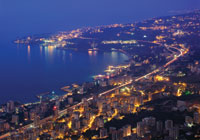 |
|
Lebanon ... massive tourist potential |
LEBANON
The year 2003 marked a milestone for Lebanon, with the country pulling year one million tourists for the first time in 20 years, on the heels of good growth in 2001 and 2002 when its hospitality sector grew by 13 percent and 14 percent respectively
Lebanon’s tourism industry has substantially expanded over the year, yet it only accounts for 10-12 per cent of the gross domestic product, compared to 20 per cent in 1974.
Analysts say that potential is massive, especially if Lebanon cements its relationship with neighboring Syria and Jordan as between these three countries, there are more historic and cultural sites than anywhere else in the world.
Also, Beirut is a star attraction: walk down Parliament Square downtown by night and you could easily be forgiven for thinking you are in Paris.
Lebanon’s Tourism Ministry says that the number of foreigners arriving in the country are up in 2004 and the credit for this could be in part to a year-long advertising campaign, Rediscover Lebanon, on CNN. Other than that, the fact that new airlines like Air Arabia are flying to Beirut (the low-cost carrier has daily flights) at highly-competitive rates has also helped it attract Gulf visitors.
SYRIA
Syria plans to offer foreign investors the chance to own projects at 100 of its tourist attractions to boost the economy in a country long bypassed by European travellers.
“The current number of tourists does not meet our ambition, but we are working gradually to move from a state where tourism was not a government priority to a new reality since 2002, when tourism became one of the main engines of the economy,” Tourism Minister Saadallah Agha Al Qalaa said.
Al Qalaa said an estimated 3 million tourists visited Syria in 2004, a 47 per cent increase over the previous year’s 2.1 million. Revenue from tourism grew from $1.4 billion in 2003 to $2 billion in 2004.
He attributed the growth to a 2002 government decision to upgrade the tourism industry to a strategic sector, but said it fell well short of Syria’s potential as a tourist attraction.
Syria has a wealth of Roman ruins, crusader castles, Islamic sites and clean beaches.
But Westerners have largely shunned the country due to complicated visa procedures and fears about unrest.
Al Qalaa pointed out that unlike in neighbouring countries, there had been no attacks on tourist sites in Syria and said investment would spur the rapidly growing sector.
“We have prepared a list of 100 sites across Syria that we have to prepare for investment between now and the market date,” he added. He did not give the names of the sites.
He said the sites were chosen to reflect Syria’s richness of attractions from winter tourism through to beach, desert or environmental tourism.
Syria is also offering potential investors the chance to visit the sites and take part in workshops to discuss the investment process that he said would be transparent.The projects, which would be wholly owned by investors, were divided into four categories – under $5 million, $5-$25 million, $25-$100 million and over $100 million.
“We know that the tourism investor has for several years been thirsty for opportunities to find land ready for investment ... Here we have large lots of land ready,” he said.
The minister said Syria also had a shortage in hotel beds – it has around 40,000 – but he hoped the number would double in six years. He said every new bed would create three new jobs.
The number of European tourists has grown since Syria launched a tourist campaign targeting Europe in September 2003, he said, but the bulk of tourists – 78 per cent – came from Arab countries. Saudis were the largest group of tourists while Germans and French were the largest from Europe. The numbers of Russian and Turkish tourists were also on the rise
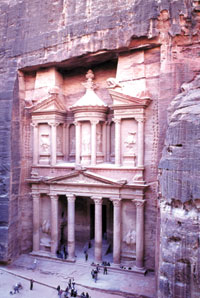 |
|
Petra ... pulling in the crowds |
JORDAN
Tourism is getting back on its feet in Jordan, with the number of nights spent by foreign visitors in the first half of this year more than doubling at 53 per cent, compared to the same period in 2003, according to the Ministry of Tourism (MoT).
The ministry’s figures reveal that foreign, or non-resident tourists spent a total of 1,495,933 nights in the first six months of 2004 compared to 976,603 last year.
The Kingdom saw a rise in the number of tourists to the country in the first half of this year, with a 30.8 per cent increase in overall arrivals compared to the same period in 2003. The number of tourists who spent the night also increased by 35 per cent in that time frame during the first six months of this year, while “same day” visitors increased by 22.6 per cent.
The Jordan Tourism Board (JTB) has been working hard to shake off the tourism slump that has placed a significant strain on the Kingdom’s hospitality sector and related service industries and has been offering special packages for visitors to Petra, which has also proved popular over 25,000 domestic tourists.
Also, the Jordan Tour Guides Association has launched its web portal www.tourguides.com.jo, as is a part of the association’s strategic plan to enhance Jordanian tourism to become more flexible, efficient and accessible.
The portal will serve as an online tool for the association, its members, and visitors to stay up to date on the developments of tourism in Jordan, to stay connected, and share information.
Mohammed Nawafleh, head of the Jordan Tour Guides Association, said that the association will work towards promoting its services and introducing members on a local and global scale through creating online presence.
The best time to visit Jordan is right now, say experts and travel industry insiders. The country is a safe destination that offers diverse and memorable experiences. Indeed, the JTB has been educating agents and the public alike that the historic Arab nation features, among other attractions, new luxury hotels, competitive prices and a host of natural attractions and sights.
The Kingdom is noted for its archaeological importance and its cultural heritage in places like Petra. Travellers from across the Middle East and overseas are learning to see the ancient treasures of Jordan’s Nabatean Kingdom of Petra in a new light. Sending tourists on an unforgettable candle light journey into the dramatic, rock-carved city, the Petra by Night programme has become increasingly popular.
Several new hotels have been opened in the country recently and more are in the planning. Also, almost half the already existing hotels are in the four- and five-star category. This highlights the high-end holiday value of Jordan, and the JTB is working to raise awareness of the country’s many top-notch facilities.
Yet, the country also serves many niche tourist markets: it is also home to many Biblical sites, making it an important multi-faith destination. Over the past few years, Jordan has been emphasising eco-tourism within the country and has several trekking, hiking and adventure options for the outdoorsy tourist. The Kingdom has a strong appeal for the traveller looking for restorative beauty with its Dead Sea spa products, now in department stores around the world. Last but not the least, the question uppermost in agents’ minds, is how much current affairs in the Middle East and around the world have affected tourism to the country. While tourist numbers showed a declined in the post 9/11 and the Iraq-War period, the renewed stability in the region has seen a rise in bookings and, overall, the tourism industry did well in 2004.
JTB, for its part, has begun a training scheme for agents to promote Jordan to the travel trade in Europe. For the Arab market, the JTB is positioning Jordan as the ideal family destination for Arab travellers, and offers a wealth of incentives unique to the Arab world.
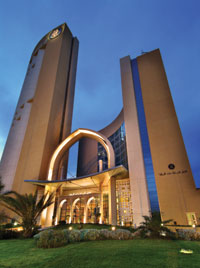 |
|
Landmark ... the Bab Al Corinthia |
LIBYA
Keen to develop its role as the Gateway to Africa, Libya has also made some impressive strides towards developing its tourism industry.
In 2003, the country’s first five-star hotel opened its doors to the public. Soaring 28 storeys high above Tripoli’s waterfront skyline, the fabulous Corinthia Bab Africa is located in the heart of Tripoli’s central business district adjacent to the old fortifications of the city.
The Corinthia Bab Africa, which has 300 rooms and suites, is a masterpiece that sets new standards of excellence on the African Continent by way of its spectacular architecture, luxurious interior design, and superior services.
It boasts a separate commercial centre, spa and extensive banqueting and conference facilities and since its launch in 2003, has quickly become the preferred venue for international and Libyan visitors. And, in another landmark deal, Libya recently signed a deal with Italian property firm Gruppo Norman to develop one of the largest tourist resorts in the North African country, a project expected to cost about $268 million.
The Farwa Island Project, in the north-west of the desert country near the Tunisian border, will be a Mediterranean holiday complex of about 1,770 rooms, to accommodate up to 3,800 guests and aimed at affluent holiday-makers.
Construction is expected to take between five and six years. The deal to develop and manage the project was one of the major non-oil related contracts signed by a Western company in Libya since the country ended decades of isolation last year and reopened its economy to foreign investment.
Details on how much money Gruppo Norman – which will not handle construction proper – will make have not been revealed as yet. Milan-based Gruppo Norman is a leading European property services company.
Also, Libya announced its intentions last year to sell-off loss-making Libyan Arab Airlines but did not set a date for the privatisation. Prime Minister Shukri Ghanem said the state would not purchase any more planes for the national carrier’s fleet. He said the private sector could buy planes in the future with the help of bank loans, adding that the state could only help by way of credits.
Ghanem added the carrier had “posted continuous losses as a result of bad management”.
Set up at the beginning of the 1970s, Libyan Arab Airlines has a fleet of only five aircraft, which serve various African, Arab and European routes, including flights to Britain and Italy.
MENATRAC
Overseas, meanwhile, a new initiative called the Middle East and North African Tourism Research Centre (Menatrec) has kicked off operations. Menatrac has been established by the Welsh School of Hospitality, Tourism and Leisure Management at the University of Wales Institute, Cardiff, to act as a catalyst for tourism research and development for the region Researchers will collaborate with colleagues from Libya, Egypt and Oman to focus on tourism development issues within the Mena and aim to maximise the benefits of the tourism industry whilst preserving the region’s unique culture and identity.
